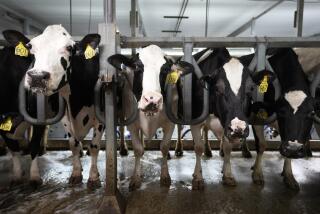A Silence Born of Crises’ Necessities
- Share via
FRANKFURT, Germany — With piles of sheep carcasses burning in Britain and 2 million cows across Europe slated for slaughter to boost flagging beef prices, these are paralyzing times for the men and women who devote their lives to defending the rights of animals.
The nightly television images of culling and carnage have drawn surprisingly little protest among the environmentalist and conservation groups that urge a more humane relationship between humans and the creatures that provide them food.
Stunned into silence by the sickening reality of crises that they have long warned were in the making--”mad cow” disease and the foot-and-mouth sickness--those who advocate better treatment of sentient beasts, even those destined for slaughter, are finding no solace in saying, “We told you so.”
“Of course we find the destruction of so many animals disturbing, especially when the food they could have provided as well as their lives are just being wasted,” said Hilmar Freiherr von Muenchhausen, head of agriculture and rural development for Germany’s chapter of the World Wide Fund for Nature. “But we cannot condemn something for which we have no alternative to propose. And we simply have to admit at this point that nothing more reasonable or humane can be done to contain these crises.”
Although animal rights advocates concede that the livestock being destroyed to prevent the spread of foot-and-mouth would eventually end up at the slaughterhouse even without the crisis, the gory images have strengthened the resolve of those who oppose eating meat.
“We have to remind people that the number of animals culled in foot-and-mouth isn’t even half the number killed every day for meat,” said Elaine Tolland of Britain’s Animal Aid office, which promotes vegetarianism.
The organization isn’t against the mass destruction aimed at containing a health crisis, she added, but believes that more humane methods are in order to prevent live animals from being thrown onto the bonfires.
Britain’s Royal Society for the Prevention of Cruelty to Animals echoes the other groups in agreeing that mass destruction is the lesser evil in comparison with allowing the livestock diseases to run rampant. But spokeswoman Emma Nutbrown said the rush to defeat foot-and-mouth is exposing the doomed animals to unnecessary suffering.
“Because they can’t be moved [due to a Europe-wide ban on livestock transports], newborn lambs are being born into mud, pigs are fighting each other because of lack of space, and feed is running low in some areas,” she said.
Rights groups say a distinction is necessary between the slaughters ordered to prevent foot-and-mouth from spreading and the wanton destruction planned to rid Europe of its oversupply of cattle at a time when beef consumption is down about 50% on the continent.
Demand for beef has dropped because of fears that eating it can spread the brain-wasting mad cow disease to humans, and there is unlikely to be any stronger market six months from now, even if food producers wanted to invest the money and energy to freeze the meat for use later.
“About all we can do is shake our heads and feel disgusted, because we’ve known for years that the European Union’s systematic overproduction of meat would some day lead to a crisis,” said Volkhard Wille, spokesman for the Assn. of Nature Protection in Bonn. “The one good thing that might be coming out of all of this horror is public awareness that we need to correct the deep-running errors of [EU] agricultural policy.”
*
Janet Stobart of The Times’ London Bureau contributed to this report.
More to Read
Sign up for Essential California
The most important California stories and recommendations in your inbox every morning.
You may occasionally receive promotional content from the Los Angeles Times.














